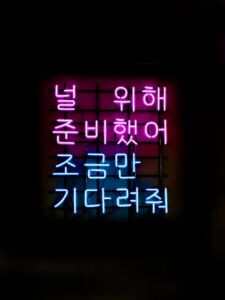-
Hello/Goodbye – 안녕하세요 – An-nyeong-ha-se-yo
This is almost certainly the most common phrase anyone in Korea will use. There are dozens of variations to account for slightly different situations and levels of respect, and it can all get really complicated. The simple solution is just to say it really fast and slur all the syllables together. Everyone will understand you, and you’ll sound like a real local. In that way you can also use this for both hello and goodbye.
Typical situation: Absolutely any meeting, greeting, arriving, departing, entering a store, sighting someone you barely know across the street, or addressing an entire school of 1200 students 12 hours after stepping off a plane.
-
Nice to meet you – 반갑습니다 – Ban-gap-sum-ni-da
The most pleasant of pleasantries; apply liberally whenever you find yourself suddenly introduced to a curious crowd of coworkers. Best served poured over a two-handed handshake. If you learn and master this then your Korean level will match the English level of most Korean school kids, whose favorite pastime will be to shout “Nice to meet you!” whenever they see you.
Typical situation: After three days at this school, you think you’ve met everyone from the principal to the janitor until someone you don’t recognize approaches you with arm outstretched. Bow, shake hands, “반갑습니다”.
-
Thank you – 감사합니다 – Kam-sa-ham-ni-da
This is probably the bare minimum for making any attempt at Korean. Use it exactly as you would it’s English equivalent.
Typical situation: Don’t know what they’re saying? It’s probably a compliment: smile and says thank you.
-
Excuse me/just a moment – 잠시만요 – Jam-shi-man-yo
Literally, “little time stop”, use this to get people’s attention, ask them to move out of the way, or tell them to wait.
Typical situation: You’re trying to get off a crowded train, but no one’s moving. If they still don’t move, they may be getting off too, just hold tight, and be prepared for the rush. Also: you’re waiting to get off a crowded train, but someone behind you thinks they get to push by you to be first out the door – tell them to wait!
-
I’m sorry -죄송합니다/미안합니다 – Chway-seong-ham-ni-da/Mi-an-ham-ni-da
There are two ways to say sorry in Korean: The first is a, “sorry I bumped into you” kind of sorry, while the second is more of a “I’m really sorry I knocked you over with my bike, please forgive me”, kind of sorry.
Typical situation: You arrive late to class: the former; You arrive late to class and with nothing prepared: the latter.
-
Right/Left/Straight – 오른/왼/직진 – O-reun/wen/jik-jin
Addresses in Korea are as confusing as a clown at a funeral, and giving one to a taxi driver can be tricky since you need to get your pronunciation just right. Too many foreigners have found themselves with a W40,000 taxi fare after mistakenly sending the driver to Sincheon instead of Sinchon. Far easier (assuming you know where you are, and where you’re going) is just to give the driver directions.
Typical situation: Giving directions to a taxi driver or talking a Korean airplane down to a safe landing, whichever you do more frequently.




